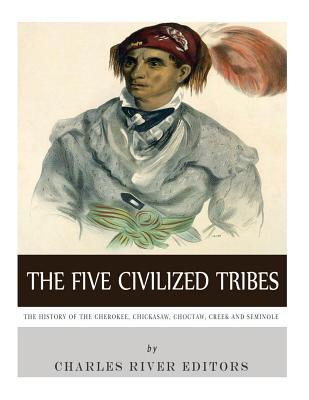*Traces the history of each tribe from their origins to today
*Includes eyewitness accounts of the Trail of Tears
*Includes a Bibliography for further reading
The Five Civilized Tribes are among the best known Native American groups in American history, and they were even celebrated by contemporary Americans for their abilities to adapt to white culture. But tragically, they are also well known tribes due to the trials and tribulations they suffered by being forcibly moved west along the Trail of Tears.
The Cherokee began the process of assimilation with whites very early, even before the establishment of the Unites States, and by the early 19th century they were one of the "Five Civilized Tribes." Ultimately, however, it is unclear what benefits "civilization" brought the tribe. Throughout the colonial period and after the American Revolution, the Cherokee struggled to satisfy the whims and desires of American government officials and settlers, often suffering injustices after complying with their desires. Nevertheless, the Cherokee continued to endure, and after being pushed west, they rose from humble origins as refugees new to the southeastern United States to build themselves back up into a powerhouse both economically and militarily. Even after being forced to leave their traditional homeland again, they once more rose to become a powerful tribe and nation, ruling themselves and building their economic power through wise and skillful leadership.
Though not as well known as the Cherokee, two of the Five Civilized Tribes were the Chickasaw and Choctaw. With roots that tie them to the Ancient Moundbuilders, the Chickasaw and Choctaw were among the most established groups in the Southeastern United States, and they were among the first natives encountered by Spanish explorer Hernando De Soto's historic expedition in the mid-16th century. They became known as two of the Five Civilized Tribes for quickly assimilating aspects of European culture, but in response to early European contact, they also became part of one of the strongest confederacies in the region. Ultimately, however, they were pushed westward during the mid-19th century and were notoriously part of the Trail of Tears.
Despite becoming a dominant regional force, infighting among the Creek brought about civil war in the early 19th century, and they were quickly wrapped up in the War of 1812 as well. By the end of that fighting, the Creek were compelled to cede millions of acres of land to the expanding United States, ushering in a new era that found the Creek occupying only a small strip of Alabama by the 1830s.
With the Spanish Empire foundering during the mid-19th century, the young United States sought to take possession of Florida. President Andrew Jackson's notorious policy of Indian Removal led to the Seminole Wars in the 1830s, and that was already after General Andrew Jackson had led American soldiers against the Seminole in the First Seminole War a generation earlier. The Seminole Wars ultimately pushed much of the tribe into Oklahoma, and the nature of some of the fighting remains one of the best known aspects of Seminole history among Americans.
The Five Civilized Tribes comprehensively covers the culture and history of the famous tribes, profiling their origins, their famous leaders, and their lasting legacy. Along with pictures of important people, places, and events, you will learn about the Cherokee, Chickasaw, Choctaw, Creek, and Seminole like you never have before.
